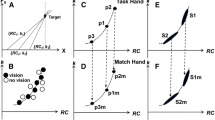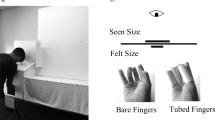Abstract
Manual estimates without vision of the hand are thought to constitute a form of cross-modal matching between stimulus size and finger opening. However, few investigations have systematically looked at how manual estimates relate a perceived size to the response across different ranges of stimuli. In two experiments (N = 18 and N = 14), we sought to map out the response properties for (1) manual estimates of visually presented stimuli as well as (2) visual estimates of proprioceptive stimuli, and to test whether these properties depend on the range of stimuli. We also looked at whether scalar variability is present in manual estimates, as predicted by Weber’s Law for perceptual tasks. We found that manual estimates scale linearly and with a slope of close to 1 with object sizes up to 90 mm, before participants’ hand size limited their responses. In contrast, we found a shallower response slope of about 0.7 when participants performed the inverse task, adjusting the size of a visual object to match a not actively chosen, induced finger opening. Our results were mixed with regards to scalar variability in large objects. We saw some indication of a plateau, but no evidence for an effect of mechanical constraints in the range studied (up to 90 mm). Participants also showed a clear tendency to overestimate small differences when a set of objects differed little in size, but not when stimulus differences were more pronounced.







Similar content being viewed by others
Notes
Two things should be noted for the fits in the narrow range: First, while these models provided a nearly perfect fit on aggregate (Fig. 6b), they did not provide a good fit on an individual basis. The reason for this is primarily the huge inter-individual variability of both the mean responses and the slopes (Fig. 7). Second, for the three-parameter power function \(y=a \times {x^b}+c\), the fitting algorithm did not converge due to the small spacing of values on the x axis.
References
Akaike H (1974) A new look at the statistical model identification. IEEE Transactions on Automatic Control AC-19, pp 716–723
Boyd IA (1980) The isolated mammalian muscle spindle. Trends Neurosci 3:258–265. https://doi.org/10.1016/0166-2236(80)90096-X
Bruno N, Uccelli S, Viviani E, De’Sperati C (2016) Both vision-for-perception and vision-for-action follow Weber’s law at small object sizes, but violate it at larger sizes. Neuropsychologia 91:327–334. https://doi.org/10.1016/j.neuropsychologia.2016.08.022
Burnham KP, Anderson RP (2004) Multimodel Inference: Understanding AIC and BIC in Model Selection. Sociol Methods Res 33(2):261–304. https://doi.org/10.1177/0049124104268644
Button KS, Ioannidis JPA, Mokrysz C, Nosek BA, Flint J, Robinson ESJ, Munafò MR (2013) Power failure: Why small sample size undermines the reliability of neuroscience. Nat Rev Neurosci 14(5):365–376. https://doi.org/10.1038/nrn3475
Cohen J (1988) Statistical power analysis for the behavioral sciences, 2nd edn. Psychology Press, New York
Davarpanah Jazi S, Heath M (2014) Weber’s law in tactile grasping and manual estimation: feedback-dependent evidence for functionally distinct processing streams. Brain Cogn 86:32–41
Dewar MT, Carey DP (2006) Visuomotor “immunity” to perceptual illusion: A mismatch of attentional demands cannot explain the perception-action dissociation. Neuropsychologia 44(8):1501–1508. https://doi.org/10.1016/j.neuropsychologia.2005.11.010
Efron B, Tibshirani RJ (1993) An introduction to the bootstrap. Chapman & Hall, New York
Ernst MO, Banks MS (2002) Humans integrate visual and haptic information in a statistically optimal fashion. Nature 415:429–433
Faul F, Erdfelder E, Lang AG, Buchner A (2007) G*Power 3: A flexible statistical power analysis program for the social, behavioral, and biomedical sciences. Behav Res Methods 39(2):175–191
Fechner GT (1860) Elemente der Psychophysik. Breitkopf und Haertel, Leipzig
Franz VH (2003) Manual size estimation: a neuropsychological measure of perception? Exp Brain Res 151:471–477
Franz VH, Loftus GR (2012) Standard errors and confidence intervals in within-subjects designs: generalizing Loftus and Masson (1994) and avoiding the biases of alternative accounts. Psychon Bull Rev 19:395–404
Frost C, Thompson SG (2000) Correcting for regression dilution bias: Comparison of methods for a single predictor variable. J R Stat Soc Ser A 163:173–189
Gallivan JP, Logan L, Wolpert DM, Flanagan JR (2016) Parallel specification of competing sensorimotor control policies for alternative action options. Nat Neurosci 19(2):320–326. https://doi.org/10.1038/nn.4214
Ganel T, Chajut E, Algom D (2008) Visual coding for action violates fundamental psychophysical principles. Curr Biol 18(14):R599–R601
Ganel T, Namdar G, Mirsky A (2017) Bimanual grasping does not adhere to Weber’s law. Sci Rep 7:6467. https://doi.org/10.1038/s41598-017-06799-4
Greenhouse SW, Geisser S (1959) On methods in the analysis of profile data. Psychometrika 24:95–112
Haffenden AM, Schiff KC, Goodale MA (2001) The dissociation between perception and action in the Ebbinghaus illusion: Nonillusory effects of pictorial cues on grasp. Curr Biol 11:177–181
Haubensak G (1992) The consistency model: a process model for absolute judgements. J Exp Psychol Hum Percept Perform 18(1):303–309
Heath M, Manzone J (2017) Manual estimations of functionally graspable target objects adhere to Weber’s law. Exp Brain Res. https://doi.org/10.1007/s00221-017-4913-8
Kopiske KK, Bruno N, Hesse C, Schenk T, Franz VH (2016a) The functional subdivision of the visual brain: Is there a real illusion effect on action? A multi-lab replication study. Cortex 79:130–152. https://doi.org/10.1016/j.cortex.2016.03.020
Kopiske KK, Gornik A, Franz VH (2016b) Manual estimation: Feedback affects bias but not precision. J Vis 16(12):450. https://doi.org/10.1167/16.12.45
Kopiske KK, Bruno N, Hesse C, Schenk T, Franz VH (2017) Do visual illusions affect grasping? Considerable progress in a scientific debate. A reply to Whitwell Goodale, 2016. Cortex 88:210–215. https://doi.org/10.1016/j.cortex.2016.10.012
Kuling IA, Brenner E, Smeets JBJ (2013) Proprioception is robust under external forces. PLoS One 8(9):e74236. https://doi.org/10.1371/journal.pone.0074236
Kuling IA, van der Graaff MCW, Brenner E, Smeets JBJ (2017) Matching locations is not just matching sensory representations. Exp Brain Res 235:533–545. https://doi.org/10.1007/s00221-016-4815-1
Loftus GR, Masson MEJ (1994) Using confidence intervals in within-subject designs. Psychon Bull Rev 1:476–490
Löwenkamp C, Gärtner W, Haus ID, Franz VH (2015) Semantic grasping escapes Weber’s law. Neuropsychologia 70:235–245. https://doi.org/10.1016/j.neuropsychologia.2015.02.037
Manzone J, Jazi SD, Whitwell RL, Heath M (2017) Biomechanical constraints do not influence pantomime-grasping adherence to Weber’s law: a reply to Utz et al. (2015). Vision Res 130:31–35. https://doi.org/10.1016/j.visres.2016.09.018
Poulton EC (1967) Population norms of top sensory magnitudes and S. S. Stevens’ exponents. Percept Psychophys 2(7):312–316. https://doi.org/10.3758/BF03211049
R Core Team (2015) R: a language and environment for statistical computing. Vienna, Austria: R Foundation for Statistical Computing. https://www.r-project.org. Accessed 11 Feb 2017
Schenk T, Utz KS, Hesse C (2017) Violations of Weber’s law tell us more about methodological challenges in sensorimotor research than about the neural correlates of visual behaviour. Vis Res 140:140–143. https://doi.org/10.1016/j.visres.2017.05.017
Searle SR, Casella G, McCulloch CE (1992) Variance components. Wiley, New York
Shadmehr R (2017) Distinct neural circuits for control of movement vs. holding still. J Neurophysiol 117(4):1431–1460. https://doi.org/10.1152/jn.00840.2016
Smeets JBJ, Brenner E (1999) A new view on grasping. Mot Control 3(3):237–271
Smeets JBJ, Brenner E (2008) Grasping Weber’s law. Curr Biol 18(23):R1089–R1090
Stevens SS (1946) On the theory of scales of measurement. Science 103:677–680
Stevens SS (1957) On the psychophysical law. Psychol Rev 64(3):153–181
Stevens SS (1959) Cross-modality validation of subjective scales for loudness, vibration, and electric shock. J Exp Psychol 57(4):201–209
Stevens SS, Stone G (1959) Finger span: ratio scale, category scale, and JND scale. J Exp Psychol 57(2):91–95. https://doi.org/10.1037/h0048829
Teghtsoonian R (1971) On the exponents in Stevens’ law and the constant in Ekman’s law. Psychol Rev 78(1):71–80. https://doi.org/10.1037/h0030300
Teghtsoonian R (1973) Range effects in psychophysical Scaling and a revision of Stevens’ law. Am J Psychol 86(1):3–27
Teghtsoonian M, Teghtsoonian R (1971) How repeatable are Stevens’s power law exponents for individual subjects? Percept Psychophys 10(3):147–149. https://doi.org/10.3758/BF03205774
Utz KS, Hesse C, Aschenneller N, Schenk T (2015) Biomechanical factors may explain why grasping violates weber’s law. Vis Res 111(Part A):22–30. https://doi.org/10.1016/j.visres.2015.03.021
van Kemenade BM, Arikan BE, Kircher T, Straube B (2016) Predicting the sensory consequences of one’s own action: First evidence for multisensory facilitation. Atten Percept Psychophys 78:2515–2526. https://doi.org/10.3758/s13414-016-1189-1
Whitwell RL, Goodale MA (2017) Real and illusory issues in the illusion debate (Why two things are sometimes better than one): Commentary on Kopiske et al. (2016). Cortex 88:205–209. https://doi.org/10.1016/j.cortex.2016.06.019
Wolpert DM, Ghahramani Z, Jordan MI (1995) An internal model for sensorimotor integration. Science 269:1880–1882. https://doi.org/10.1126/science.7569931
Acknowledgements
This work did not receive external funding. The authors have no competing interest in its publication. We thank Evan Cesanek for helpful advice and for proofreading the manuscript.
Author information
Authors and Affiliations
Corresponding author
Rights and permissions
About this article
Cite this article
Kopiske, K.K., Domini, F. On the response function and range dependence of manual estimation. Exp Brain Res 236, 1309–1320 (2018). https://doi.org/10.1007/s00221-018-5223-5
Received:
Accepted:
Published:
Issue Date:
DOI: https://doi.org/10.1007/s00221-018-5223-5




